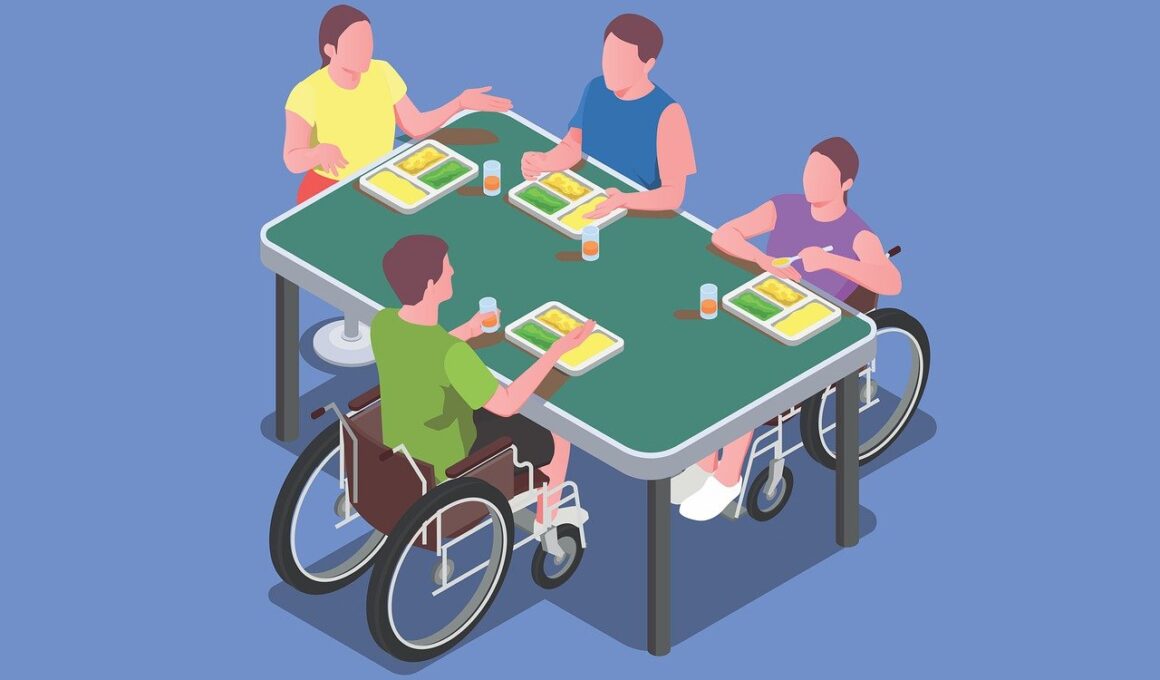Adaptive Dance Movements to Enhance Flexibility and Balance
Dance movements can be transformative for individuals with disabilities, offering a unique approach to enhancing flexibility and balance. Adaptive dance is tailored to accommodate various abilities, ensuring everyone can participate. Through dance, individuals learn to express themselves physically, which creates a sense of freedom and joy. Various adaptive techniques are incorporated, allowing dancers to explore movements in a way that feels comfortable and natural to them. By providing modifications, instructors ensure that participants can engage fully, regardless of their physical limitations. Dance fosters not only physical growth but emotional connections among participants. The shared experience builds a sense of community, encouraging individuals to support one another. In addition to enhancing physical health, adaptive dance can significantly improve mental well-being. Combined with the empowerment felt through movement, the social component of dance works wonders for self-esteem. Control over flexibility improves daily living skills significantly. Each session provides an opportunity for growth, supporting overall mobility advancements. As instructors guide through specific movements, they empower participants to challenge their abilities in safe, supportive environments.
Understanding the principles behind adaptive dance allows professionals to effectively meet the needs of each participant. The primary goal is to create an inclusive environment where all individuals can thrive. Recognizing the importance of individualized adaptations, instructors assess abilities carefully. This includes considering physical, cognitive, and emotional factors when developing lesson plans. By focusing on each dancer’s unique strengths, instructors can tap into their potential. Adaptive props may be utilized to enhance movements further, contributing to overall balance and coordination. For instance, using chairs, resistance bands, or floor mats allows participants to explore different levels and dynamics in their dance practice. Additionally, incorporating music tailored to individual preferences enhances motivation and engagement during sessions. Instilling a sense of rhythm can significantly bolster participants’ coordination. Dancers can create sequences aligned with their preferred styles, transforming the experience into a catered journey. An essential aspect of adaptive dance is developing programs that foster a sense of achievement. When individuals see progress in their flexibility and balance, they experience a heightened sense of self-confidence.
Benefits of Adaptive Dance
Engaging in adaptive dance movements fosters significant improvements in both flexibility and balance over time. Physical improvements include increased muscle strength and enhanced joint mobility. Regular practice helps maintain flexibility, allowing participants to perform daily tasks more efficiently. Moreover, adaptive dance helps reduce the risk of injury by promoting better body awareness and control. Participants learn how to move safely, developing skills that transfer to their everyday lives. Beyond physical enhancements, the psychological benefits of dance cannot be overstated. Engaging in rhythmic movement encourages the release of endorphins, contributing to improved mood and mental health. Reduced feelings of anxiety and depression are common outcomes associated with dance movements. Additionally, participants develop valuable social skills through interactions during classes. Building relationships with peers improves cooperation and collaboration, important skills in any community. Furthermore, adaptive dance often cultivates a sense of belonging, helping individuals feel more connected. Many participants report the pleasure of experiencing their bodies in a new light, which nurtures a positive self-image. Ultimately, these benefits extend beyond the dance class, affecting various aspects of life positively.
Another essential aspect of adaptive dance is ensuring the accessibility of space and materials, making it inclusive for everyone. Studios should accommodate various needs by ensuring suitable flooring, enough room for movement, and accessible entrances. Clear communication about what to expect during sessions allows participants to prepare mentally and physically. Moreover, instructors must remain adaptable, ready to modify class plans based on participants’ responses and needs. Observing how individuals interact with specific movements helps teachers refine their approaches over time. This continuous process of adaptation ensures that everyone receives optimal support. In addition, it encourages personal growth not just physically but also holistically. Feedback from participants can enhance program effectiveness, resulting in a collaborative environment based on open communication. Participants feel empowered and involved in their resilience journey while instructors can adjust teaching methods to maximize benefits. Adaptive dance thrives on creativity, and exploring new ideas with flexibility ensures an enriching experience tailored to all abilities. Finally, creating a supportive atmosphere encourages participants to challenge themselves and embrace the transformative power of movement.
Inclusive Community Engagement
Adaptive dance movements also provide opportunities for community engagement and awareness. Seeking collaboration with local organizations can lead to broader participation and support for adaptive dance programs. Events such as performances or showcases should be organized to demonstrate the positive impacts of adaptive dance on individuals’ lives. Sharing success stories helps foster awareness and understanding surrounding disability representation in the arts. Moreover, these events emphasize the notion of inclusivity, encouraging others to explore the benefits of adaptive dance. Families, friends, and supporters can become involved, creating a community that values diversity and advocates for equitable access. Providing educational workshops for caregivers and community members can deepen understanding about adaptive practices, bridging gaps in knowledge and empathy. Community engagement transforms the perception of disabilities and promotes visibility for underrepresented groups. By highlighting the dancers’ achievements, observers gain insights into the power of movement. Adaptive dance champions a message of empowerment, demonstrating that everyone deserves the opportunity to experience art and creativity. This cultural shift fosters a lasting legacy, inspiring future generations to embrace dance regardless of individual challenges.
In conclusion, adaptive dance movements serve as a powerful means of enhancing flexibility and balance for individuals with disabilities. Through personalized approaches, participants gain access to physical, emotional, and social benefits, leading to holistic improvements in their lives. Each dance class nurtures not only physical strength but cultivates a positive mindset and belief in one’s abilities. The movement ultimately reminds everyone about the innate power of self-expression through dance. Connecting with others in an inclusive environment fortifies the values of empathy, support, and shared experiences. The multi-faceted benefits of adaptive dance create lasting impressions, supporting individuals’ overall well-being. As awareness grows, more communities embrace the need for accessible programs, broadening participation and acceptance. Dance transcends barriers and enables individuals to create meaningful connections while developing essential skills; this is vital in today’s world. It is vital for instructors to continue innovating, seeking ways to enhance adaptability further to continue empowering participants. Adaptations in dance will evolve alongside advancements in understanding disabilities. Flexibility and balance are just two of many aspects improved through adaptive dance, proving its value as an essential practice for those seeking transformation.
Encouraging Future Development
The demand for adaptive dance in various settings is steadily growing, indicating a positive trend toward inclusivity. Schools, community centers, and rehabilitation programs increasingly recognize the importance of adaptive dance for individuals with disabilities. Collaboration between advocates, instructors, and organizations will help expand accessible opportunities for participants everywhere. Research should continue to support the benefits of adaptive dance, facilitating funding for programs catering to diverse needs. Furthermore, understanding various disabilities and their implications for movement paves the way for further innovations in adaptive dance practices. Engaging with diverse groups also opens the door for new perspectives on performance styles and techniques. This engagement enriches the overall dance community and fosters a celebration of differences. Continuous training for instructors ensures they are equipped to create an inclusive atmosphere where all feel welcome. Encouraging participants to explore their creativity, each dancer can express themselves through unique movements. Performing at local events, schools, or festivals connects participants with a broader audience, fostering greater awareness about adaptive dance. Individually and collectively, each step forward demonstrates resilience and commitment to creating a more inclusive world through the beauty of dance.
In summary, adaptive dance movements represent a vital and transformative practice for enhancing flexibility and balance, particularly for individuals with disabilities. By focusing on tailored approaches, instructors make dance accessible to everyone, fostering an environment centered on growth, support, and creativity. This inclusivity contributes not just to physical improvements but strengthens emotional bonds between participants as well. When individuals feel connected, they experience the strength of community support, empowering them to explore their dance journey further. Ultimately, adaptive dance offers a pathway to personal empowerment and self-discovery for dancers, redefining societal perceptions around disabilities. As we continue to engage in dialogue about inclusivity, the practices surrounding adaptive dance will continue to evolve and adapt. These movements uplift individuals while also emphasizing the power of expression and collaboration. Promoting education around this important topic invites more participants and encourages acceptance within the arts. Organizations dedicated to supporting adaptive dance can play a crucial role in securing funding and resources, facilitating further advancement in the community. With dedicated efforts, the future of adaptive dance movements promises continued growth, ensuring that everyone has the opportunity to dance freely and joyfully.


